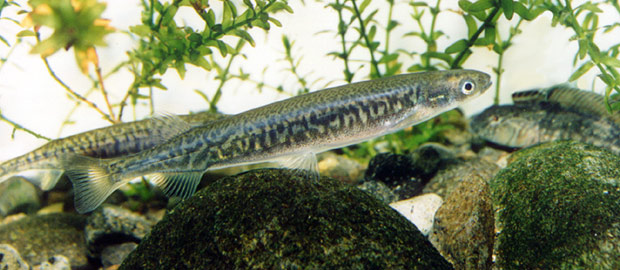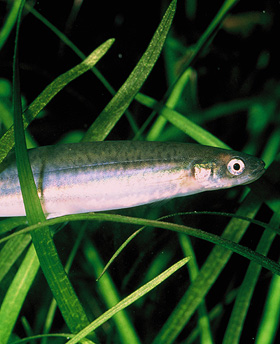|
|
| |
 |
| |
Home > New Zealand ecology > Native galaxiid fish > Inanga |
| |
| |
NEW ZEALAND ECOLOGY |
|
| |
|
|
|
|
NATIVE GALAXIID FISH |
|
| |
|
| |
| |
Inanga Galaxias maculatus, also known as common galaxias, belongs to the Galaxiidae family of the Osmeriformes order. It is widespread in the southern hemisphere, and was first described by Jenyns in 1842.
Inanga is one of only two Galaxias species, and five species of New Zealand freshwater fish that are not endemic. It has no threatened listing, and is the most widespread of New Zealand's galaxiids, occurring all around the mainland coast and offshore islands.
It is one of the world's most widespread freshwater fish, found in southeastern Australia, Tasmania, southwest Western Australia, Chile, Argentina, the Falkland Islands, New Caledonia and some Pacific Islands. |
| |
 |
| |
Inanga is the smallest Galaxias species, but the most common, and makes up the bulk of the whitebait run. |
| |
 |
| |
Inanga make up the majority of the whitebait catch in most rivers and streams. Adult inanga are the smallest of the five whitebait Galaxiasspecies, rarely more than 11 cm long.
Inanga inhabit open rivers, streams, lakes, and heavily vegetated swamps near the coast. Unlike shortjaw kokopu, banded kokopu and koura, inanga are very poor climbers, and do not penetrate any distance inland unless the river gradient is very gradual.
They are consequently restricted to the lower reaches of rivers and streams, where greater damage to riparian areas through conversion to pasture on alluvial terraces, and construction of utik\lities has occurred.
Their silvery belly and somewhat forked tail make them easy to distinguish from the other galaxiids except for their close relative the dwarf inanga, a species restricted to some dune lakes near Dargaville.
Smelt frequent similar habitat to inanga and can be confused with them. However, smelt have scales and an adipose fin, features that are easy to see on close examination.
Fishing pressure was the target of a recent study on the Mokau River, which used dye-stained whitebait to determine the number of fish that escaped past anglers' nets. This showed that whitebaiters caught a relatively small proportion of the run [NIWA].
A parallel study showed that only about 20 percent of the whitebait that escaped survived to reach adulthood. Historically, their abundance has been greatly reduced nationwide by swamp and wetland drainage [NIWA].
Introduced fish (trout, gambusia) are also thought to have reduced inanga. The reduction of spawning habitat on the banks of rivers and streams is believed to be the major limiting factor.
The eggs remain above the water level until the next spring tide when they hatch and are washed out to sea. Modification of the tidally affected regions of stream and river banks by cattle browsing and flood control works have no doubt destroyed much spawning habitat.
Large rounded single dorsal and anal fins are set back close to the large square caudal fin.
As with all galaxiids inanga do not have scales, but have a leathery, thick skin covered with mucus. |
| |
 |
| |
|
 |
| |
 Click on image above for another inanga photo Click on image above for another inanga photo
 Double click on 2nd image to return to first Double click on 2nd image to return to first
Inanga Galaxias maculatus with a bluegill bully Gobiomorphus hubbsi in the background.
1st image: Stephen Moore, Crown Copyright © Department of Conservation
2nd image: Copyright © Stephen Moore
 See more on native galaxiid fish See more on native galaxiid fish
 See "The Galaxias genus throughout the southern hemisphere" See "The Galaxias genus throughout the southern hemisphere" |
| |
 |
| |
Whitebait and the breeding cycle of diadromous galaxiids
New Zealand's freshwater fish fauna is sparse with 41 native species in 9 families, but unique with the predominance of 24 species of Galaxias and Neochanna genera in the Galaxiidae family.
More than half of the freshwater fish fauna is diadromous, moving between fresh and salt water during their life cycle.
The five whitebait galaxiids, shortjaw kokopu, giant kokopu, banded kokopu, inanga and koaro are amphidromous, a particular form of diadromy relating to breeding in freshwater. |
| |
 |
| |
Inanga Galaxias maculatus Photo G.A. Eldon, Crown Copyright © Department of Conservation |
 |
| |
Adult galaxiids make their way downstream to rivermouths in the autumn to spawn. Thousands of eggs are laid amongst vegetation on river and stream banks flooded by a spring (very high) tide. Males fertilize the eggs with large amounts of sperm (milt) that make the water milky.
When the tide recedes the eggs sit out of water for two weeks or more remaining moist in the vegetation until the next spring tide, when they hatch and larvae are washed out to sea.
After spending four to five months of winter in the ocean, large shoals of juvenile fish (whitebait), up to 5 cm long and 3 to 4 mm wide, swim into river and stream estuaries on the incoming tide in spring. They make their way upstream to develop into adult freshwater fish.
The tiny, almost transparent New Zealand whitebait, caught in a net or screen, are primarily the migratory juveniles of inanga, koaro, and banded kokopu. Inanga make up the bulk of the whitebait catch in New Zealand, but are not present in sufficient quantities in Australia and South America.
The regulated whitebait season is from mid-August until the end of November throughout most of New Zealand except Westland. Any whitebait catch outside this period is prohibited. There are restrictions on the size of fishing gear, but there is no catch limit.
In 1902, McKenzie argued that whitebait were a distinct species from the Galaxias species, and not the young of another fish. This claim continued until 1928 when Hope kept whitebait in captivity, and watched them grow into inanga.
At different times and in some parts of the country, whitebait runs also include juvenile and adult Retropinna (smelt); juvenile Gobiomorphus (bullies), and Anguilla (eel) species. The whitebait of grayling Prototroctes oxyrhynchus were also in the runs before it became extinct.
|
| |
 |
| |
|
|
The ancient Gondwana ancestry of galaxiid fish .....
Inanga's distribution throughout Gondwana countries of the southern hemisphere, and koaro G. brevipinnis in southeastern Australia and Tasmania, are the first indication of a Gondwanan ancestry of galaxiids.
The question remains, whether the distribution of galaxiids around the Southern Pacific ocean was by dispersal following the breakup of the Gondwana continent, and the separation of the Zealandia continent 80 million years ago; or by vicariance within Gondwana through Antarctica before separation of the continents.
Dispersal is the migration of an ancestral population across a pre-formed barrier, such as an ocean.
Vicariance is the separation of a population by a barrier, which isolates a new population, and in many cases is the initiation of speciation and the evolution of new species.
| |
 |
| |
The linked continents of South America, Antarctica, Australia and New Zealand were an overland dispersal route 130 to 35 million years ago. |
| |
 |
| |
Evidence of a vicariant origin of the New Zealand freshwater fauna is provided by a relationship between Galaxiid fish and tiny parasitic larva of the freshwater mussel, genus Hyridella, called a glochidium.
The larva attach to the fish's gills to obtain nutrients and get a free ride. The minute larval would be washed away in the current without an attachment to the fish.
By coincidence, the mussel family Hyriidae occurs in New Zealand, South America and eastern Australia in the same habitat with galaxiid fishes.
The dispersal of larva to coincide with the galaxiid fish, and evolution of the same relationship on different continents, would have been an ecological phenomenon that is hard to imagine. It is easier to accept vicariant separation of populations, when the larva and fish were associated before Gondwana broke up.
Deretrema philippae is a parasite found in the intestine of inanga in New Zealand. Teganoderma szidati, another intestinal parasite, has similarly been reported in the gut of Argentinian inanga.
An ancient ancestry, Gondwana origin, and vicariant origin of New Zealand freshwater fauna further revolves around the only two species of freshwater crayfish Paranephrops planifrons and P. zealandicus. Crayfish relatives in the Parastacidae family in Australia (yabby), and South America are thought to be of Gondwanan origin.
Another convincing coincidence is the relationship between flatworms of the genus Temnocephala that attach to the claws of koura. They only live on a host.
Temnocephala have the same relationship with freshwater crayfish in Australia, and other relatives attach themselves to various hosts, including snails, crayfish and turtles in Brazil, Chile, Argentina, Uruguay, Indonesia and New Guinea.
|
| |
 |
|

